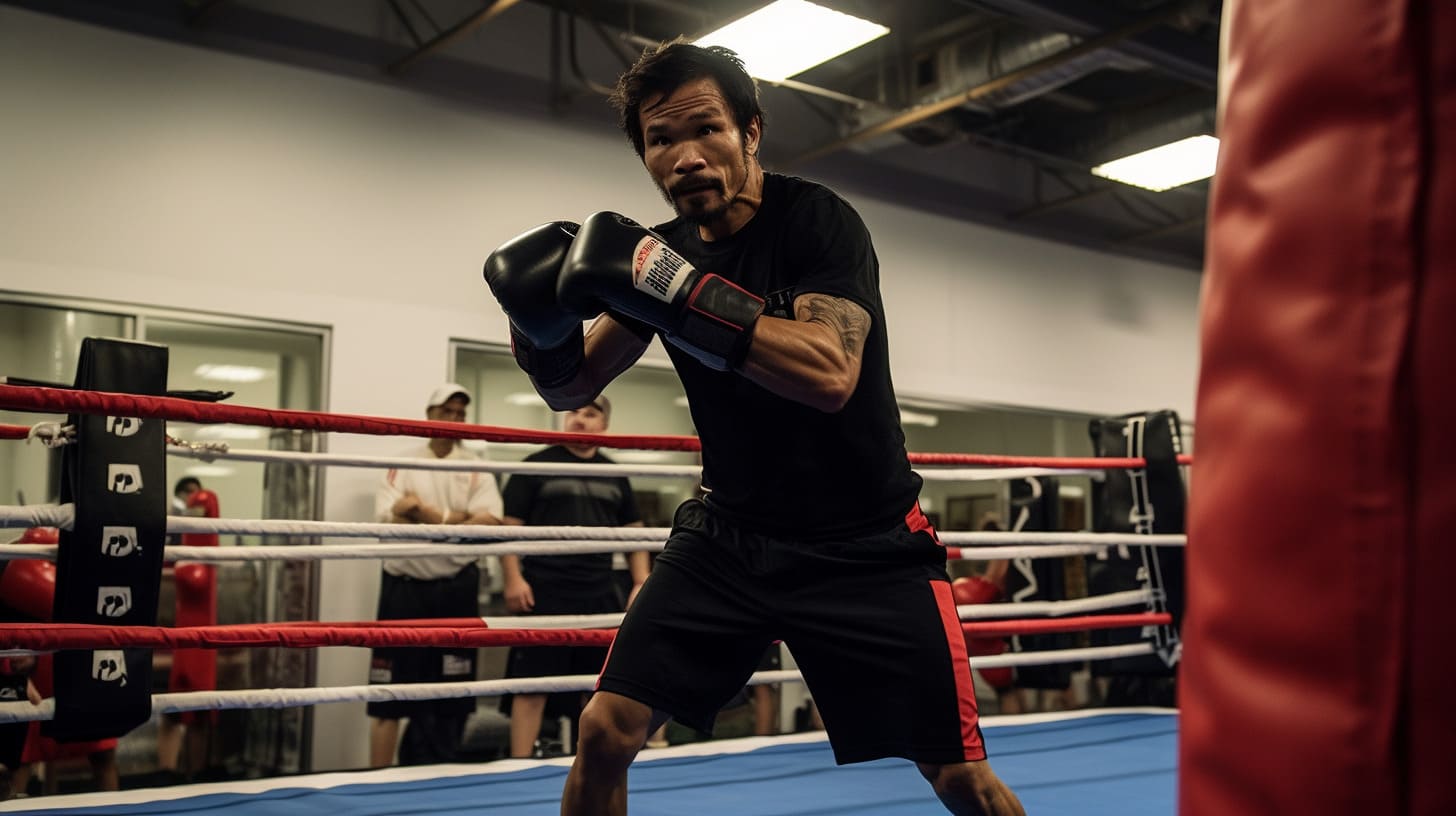Shadow boxing is a workout that involves throwing punches and moving around as if fighting against an invisible opponent. It is a staple in boxing training and has been used for centuries to improve technique, speed, and footwork. This high-intensity workout has benefits for both physical and mental health, making it an ideal exercise for individuals of all ages and expertise levels.
- Age (35+): As we age, our bodies become less resilient and prone to injury. Shadow boxing is a low-impact exercise that can still provide a full-body workout without putting excessive strain on joints and muscles.
- Experience in Boxing: For those who have experience in boxing, shadow boxing can help improve techniques and maintain muscle memory even when not in the ring.
Apart from these specific groups, shadow boxing has several physical benefits, such as:
- Improves Cardiovascular Health: The constant movement and throwing of punches in shadow boxing is an excellent form of cardiovascular exercise that can improve heart health and endurance.
- Increases Muscle Endurance: The repetitive nature of shadow boxing can increase muscle endurance, making it easier to perform for longer periods without fatigue.
- Enhances Coordination and Balance: Shadow boxing involves coordinating footwork and punching combinations, which can improve overall coordination and balance.
The mental benefits of shadow boxing include:
- Reduces Stress and Anxiety: The physical movement and release of endorphins during a shadow boxing workout can help reduce stress and anxiety levels.
- Improves Focus and Concentration: The need to stay alert and focused during a shadow boxing workout can improve overall concentration and mental clarity.
- Boosts Confidence and Self-Esteem: As a full-body exercise, shadow boxing can lead to improvements in physical appearance and overall confidence.
To do a shadow boxing workout, follow these steps:
- Warm-up and Stretching: Begin with a light jog and then stretch out your arms, shoulders, and legs to prepare for the workout.
- Shadow Boxing Rounds: Start with 3-minute rounds of shadow boxing, focusing on proper form and incorporating footwork and punching combinations.
- Cool Down and Stretching: Finish the workout with a light jog and then stretch out your muscles to prevent soreness.
To have a successful shadow boxing workout, keep these tips in mind:
- Use Proper Form and Technique: To avoid injury and get the most out of the workout, pay attention to your form and technique.
- Incorporate Footwork and Movement: Shadow boxing should incorporate footwork and movement to simulate real fighting scenarios.
- Mix Up Punch Combinations: To challenge yourself and improve overall technique, mix up your punch combinations during the rounds.
- Focus on Breathing and Relaxation: Don’t forget to breathe properly and stay relaxed during the workout to prevent fatigue and tension in muscles.
What Is Shadow Boxing?
Shadow boxing is a solo workout performed by fighters, where they throw punches at an imaginary opponent. It helps improve technique, footwork, and agility. Incorporating various strikes and defensive moves, it’s a full-body workout that enhances cardiovascular endurance and muscular strength. It’s an effective way to practice different combinations and strategies without physical contact, making it a valuable training method for boxers, MMA fighters, and martial artists.
Who Can Benefit From Shadow Boxing?
Shadow boxing is a dynamic and versatile workout that can be beneficial for a wide range of individuals. Whether you are young or old, a beginner or experienced in boxing, this workout has something to offer. In this section, we will discuss who can benefit from shadow boxing by examining two key factors: age and experience in boxing. By understanding the potential benefits for different demographics, you can determine if shadow boxing is the right workout for you.
1. Age
- Consult a healthcare professional to assess physical readiness and potential limitations based on age.
- Start with basic movements and gradually increase intensity based on individual fitness levels and age.
- Focus on proper form and technique to prevent injuries and maximize benefits, taking into consideration age-related challenges.
- Listen to your body and adjust the workout to accommodate any age-related challenges.
Shadow boxing, used by ancient civilizations for combat training, evolved into a popular fitness regimen across cultures.
2. Experience in Boxing
To effectively engage in shadow boxing, prior experience in boxing is crucial. Beginners should concentrate on mastering fundamental techniques and movements before moving on to more advanced combinations. Experienced boxers can utilize shadow boxing to perfect their existing skills and acquire new ones, such as improving speed, agility, and defensive tactics.
Get ready to punch your way to a healthier heart, stronger muscles, and better balance with shadow boxing – no actual opponents required.
What Are The Physical Benefits Of Shadow Boxing?

Shadow boxing may seem like a simple exercise, but its benefits go far beyond just punching the air. In this section, we will explore the physical benefits of shadow boxing and how it can improve your overall fitness. From improving cardiovascular health to increasing muscle endurance and enhancing coordination and balance, shadow boxing offers a full-body workout that can benefit people of all ages and fitness levels. Let’s dive into the specifics of how shadow boxing can benefit your physical health.
1. Improves Cardiovascular Health
Shadow boxing is an effective way to improve cardiovascular health by following these steps:
- Engaging in continuous movement that elevates heart rate.
- Enhancing circulation, which promotes heart and lung function.
- Increasing stamina and endurance, leading to improved overall cardiovascular fitness.
2. Increases Muscle Endurance
To increase muscle endurance through shadow boxing, follow these specific steps to optimize your workout:
- Gradually build muscular endurance by performing longer rounds with shorter rest intervals.
- Challenge your muscles by incorporating resistance training, such as holding light weights or wearing weighted gloves, during shadow boxing.
- Engage your muscles effectively by focusing on maintaining proper form and technique throughout the entire workout.
Who needs a tightrope when you have shadow boxing to improve your balance and coordination?
3. Enhances Coordination and Balance
- Stand in a stable stance with your feet shoulder-width apart.
- Keep your core engaged and maintain a slight bend in your knees.
- Focus on your footwork, shifting weight smoothly from one foot to the other while throwing punches.
- Coordinate your hand-eye movements, ensuring your punches are aligned with your visual targets.
- Practice maintaining equilibrium while executing different punch combinations.
To improve coordination and balance during a shadow boxing workout, focus on fluidity in movements and precision in punches. Incorporate a variety of footwork patterns to challenge your balance and coordination. Additionally, visualize an opponent to enhance your spatial awareness and responsiveness.
Who says fighting your own shadow isn’t mentally beneficial? Shadow boxing reduces stress, improves focus, and boosts confidence – all without having to throw a punch at anyone else.
What Are The Mental Benefits Of Shadow Boxing?

While shadow boxing is often associated with physical fitness, its mental benefits should not be overlooked. In fact, incorporating shadow boxing into your workout routine can have a significant impact on your mental well-being. In this section, we will delve into the mental benefits of shadow boxing, including how it can reduce stress and anxiety, improve focus and concentration, and boost confidence and self-esteem. By the end, you may find yourself ready to add some shadow boxing to your next workout session.
1. Reduces Stress and Anxiety
- During shadow boxing sessions, incorporate deep breathing techniques to promote relaxation and reduce stress.
- Emphasize rhythmic movements and controlled punches to channel anxiety and tension towards the workout.
- Enhance the stress-reducing effects of shadow boxing by creating a peaceful environment with calming music and proper lighting
2. Improves Focus and Concentration
- Focus on Breathing: Concentrate on syncing your breath with your movements to improve focus and concentration while also enhancing mindfulness.
- Visualize Opponents: Imagine an opponent in front of you, focusing on their movements to sharpen your concentration skills.
- Mental Rehearsal: Use shadow boxing as a mental exercise, visualizing your actions to improve your ability to concentrate.
Did you know? Shadow boxing was practiced by legendary boxer Muhammad Ali as part of his training routine, helping him to improve his focus and concentration.
Shadow boxing: where you can beat your own insecurities, one punch at a time.
3. Boosts Confidence and Self-Esteem
- Set achievable goals: Gradually increase the duration and intensity of your shadow boxing sessions.
- Visualize success: Imagine yourself mastering different techniques and combinations during your workout to boost your confidence and self-esteem.
- Seek feedback: Request constructive criticism from a trainer or mentor to refine your skills and further improve your confidence and self-esteem.
Did you know that Shadow boxing is a powerhouse cardio workout, burning upwards of 400 calories per hour?
How To Do A Shadow Boxing Workout?
Are you looking for a high-intensity workout that can be done anywhere, anytime? Look no further than a shadow boxing workout. In this section, we will break down the steps to a successful shadow boxing workout, starting with the crucial warm-up and stretching. Then, we’ll dive into the main event: shadow boxing rounds that will get your heart rate up and your muscles working. Finally, we’ll end with a cool down and stretching routine to ensure proper recovery and prevent injury. Get ready to unleash your inner fighter and get a killer workout in the process.
1. Warm-up and Stretching
Begin with a light cardio exercise, such as a 5-minute jog or jumping jacks, to increase heart rate and warm up the muscles.
Next, perform dynamic stretches that target major muscle groups, such as arm circles and leg swings, to enhance flexibility and range of motion.
Finish the warm-up with moderate-paced shadow boxing to prepare both the muscles and mind for the upcoming workout.
Make sure to customize your warm-up and stretching routine to fit your fitness level and specific workout goals.
Get ready to take on your imaginary opponents and burn some real calories in these shadow boxing rounds.
2. Shadow Boxing Rounds
- Warm-up and Stretching: Begin with 5-10 minutes of light cardio, followed by dynamic stretches for the arms, shoulders, and legs.
- Shadow Boxing Rounds: Perform 3-5 rounds of shadow boxing, focusing on different aspects like speed, power, and defense in each round.
- Cool Down and Stretching: Conclude with 5-10 minutes of light cardio and static stretches to release tension in the muscles.
Stretch it out, just like your patience while waiting for a worthy opponent.
3. Cool Down and Stretching
- Cool Down: After completing the shadow boxing rounds, make sure to transition into a cool-down phase to lower your heart rate and gradually decrease your body temperature.
- Stretching: Engage in static stretches that target the major muscle groups used during the workout to improve flexibility and prevent muscle soreness.
Shadow boxing workouts offer a wide range of physical and mental benefits, making it an ideal exercise for individuals of all fitness levels.
Just remember, your imaginary opponent can’t hit back, but your muscles will feel very real tomorrow.
What Are Some Tips For A Successful Shadow Boxing Workout?

Are you looking for a challenging and effective workout? Look no further than shadow boxing. This solo exercise has been used by boxers and martial artists for years to improve their skills and physical fitness. But how can you ensure a successful shadow boxing workout? In this section, we will discuss some tips to maximize your training session. From proper form and technique to incorporating footwork and movement, let’s dive into the key elements that will help you get the most out of your shadow boxing workout.
1. Use Proper Form and Technique
- Ensure proper stance: Stand with feet shoulder-width apart, non-dominant foot slightly forward, knees bent, and fists at chin level.
- Maintain form: Keep elbows close to the body, shoulders relaxed, and chin tucked in to protect the jaw.
- Execute punches correctly: Rotate hips and shoulders with each punch, and retract hands to the guard position swiftly.
2. Incorporate Footwork and Movement
- Start with proper stance: Position your feet shoulder-width apart, one foot in front of the other, knees slightly bent.
- Move with purpose: Utilize lateral and forward-backward movements to mimic real boxing scenarios and incorporate footwork and movement.
- Pivot and turn: Rotate your hips and feet as you throw punches, maintaining balance and agility.
3. Mix Up Punch Combinations
- Vary your punch speed and power to keep your opponent guessing.
- Incorporate jabs, hooks, uppercuts, and body shots to diversify your combinations.
- Practice transitioning seamlessly between different punches to add fluidity and unpredictability to your moves
4. Focus on Breathing and Relaxation
- Focus on Breathing: Pay attention to your breathing pattern, inhaling and exhaling deeply to maintain oxygen flow while incorporating relaxation methods like visualization or progressive muscle relaxation during shadow boxing rounds.
- Mindfulness: Stay present in the moment, focusing on the sensations of movement and the rhythm of your breath.
The Cardiovascular Power of Shadow Boxing

The heart-pounding nature of shadow boxing is where its cardiovascular prowess shines. With the potential to burn upwards of 400 calories per hour, it stands tall among other cardio workouts. The rhythmic movement of the body, coupled with the intense focus required to mimic real boxing scenarios, keeps the heart rate elevated, promoting better cardiovascular health.
The connection between shadow boxing and mastering basic boxing techniques is profound. As you glide through the air with each punch, the core tenets of boxing – stance, balance, and footwork become second nature. Mastering the Basics of Boxing is crucial to harnessing the full cardio benefits of shadow boxing. A proper stance ensures balance, enabling smooth movement and stability while punching, key elements that contribute to an effective and heart-pumping shadow boxing session.
Conclusion
Shadow boxing is more than just a workout; it’s a manifestation of the boxing spirit. The benefits it offers extend beyond the physical realm, shaping not only your body but also your character. The discipline, focus, and commitment required in shadow boxing are emblematic of the broader boxing ethos.
As you immerse yourself in the rhythmic dance of shadow boxing, you’ll find it to be a constant companion in your boxing journey. Mastering the Basics of Boxing is integral to this journey, and shadow boxing serves as a stepping stone towards achieving boxing prowess.
With no barriers to entry and boundless benefits to reap, integrating shadow boxing into your workout regimen is a decision that promises a blend of fitness, skill enhancement, and self-discovery. So, step into the invisible ring, throw your first shadow punch, and embark on a journey of self-improvement that resonates with the heart and soul of boxing.
FAQ’s
What is Shadow Boxing?
Shadow boxing is a form of boxing training where one spars with an imaginary opponent, using punches, footwork, blocking, and other techniques to both attack and defend
How Does Shadow Boxing Improve Muscle Memory?
Shadow boxing is crucial for developing muscle memory in boxing. It involves repetitive movements, like slipping and countering punches, which become encoded in muscle memory, allowing boxers to react instinctively during a fight
What Are the Key Benefits of a Shadow Boxing Workout?
Shadow boxing offers multiple benefits, including building muscles (especially around the chest, shoulder, arms, core, and legs), improving fighting conditioning and muscle memory, aiding in weight loss, improving technique, releasing stress, enhancing visualization and strategy implementation, improving footwork, and increasing coordination
How Often Should You Practice Shadow Boxing?
The frequency of shadow boxing workouts can vary based on factors like boxing experience and fitness level. While there's no strict rule, practicing 3 times a week is a good start. It's beneficial to include shadow boxing in warm-up routines and to perform it in front of a mirror or under a coach's supervision to correct form mistakes
Is Shadow Boxing Effective for Building Strength and Muscle?
While shadow boxing itself doesn't directly increase punching power or build muscle mass, it helps in toning muscles and improving the precision and power of punches. It's recommended to combine shadow boxing with additional strength training exercises for muscle mass gain
Can Shadow Boxing Replace a Punching Bag Workout?
Shadow boxing and punching bag workouts complement each other. While one is not necessarily better than the other, a well-executed shadow boxing workout can enhance the effectiveness of a punching bag workout
What Makes Shadow Boxing a Good Workout?
Shadow boxing is an excellent workout as it helps perfect boxing form, increases accuracy, and does not require equipment. It's effective for beginners to advanced fighters and provides a full-body workout that engages major muscle groups, improving form, balance, and offering stress relief
What techniques should you focus on when shadow boxing?
Focus on basic boxing moves, build up to complex combinations, balance offensive and defensive techniques, concentrate on footwork and movement, pay attention to form and precision, and use visualization to simulate real fight conditions
How can you maximize the benefits of shadow boxing?
Maximize shadow boxing benefits by practicing regularly, focusing on technique and form, using visualization for strategic thinking, varying intensity and speed, recording and reviewing sessions for improvements, and seeking guidance from experienced trainers or online resources
What are some specific drills for a shadowboxing workout?
There are many different shadowboxing workout ideas, but some common drills include jabbing, switch attacks, lateral movements, and 2-phase attacks with a change of angle. These drills help improve hand coordination, footwork, agility, and defensive skills, among others.
Should you use weights when shadow boxing?
Using weights in shadow boxing is not universally recommended due to the risk of altering natural movement and increasing injury chances. If using weights, choose light ones and maintain proper boxing technique.
How long and often should you shadow box?
Shadow box ideally 3 times a week, starting with shorter sessions and gradually increasing duration. Regular practice, consistency, and integrating shadow boxing into warm-ups are important for skill and endurance development
Is shadowboxing suitable for all ages and fitness levels?
Yes, shadowboxing can be adapted for all ages and fitness levels. It is a low-impact workout that can be modified for minimal impact and is accessible to all, including fit women, age 62, or people with a stiff body. However, it is important to listen to your body and adjust the workout accordingly.

